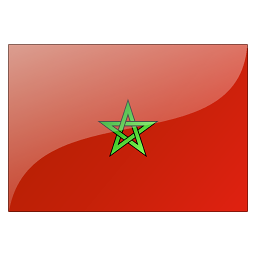



Cala Iris now lies inside the Al Hoceima National Park. It has a small fishing port and a beautiful sandy beach that's empty out of season – for now. Construction of a resort was due to start in 2017. The port is flanked by attractive beaches: Yellich (to the east) faces an island that you can walk out to; Oued Sahfa lies to the west; and an hour’s hike over the hill lies Mestaza.

Strategically located Ouarzazate (war-zazat) has gotten by largely on its wits instead of its looks. For centuries, people from the Atlas, Draa and Dadès Valleys converged to do business at Ouarzazate’s sprawling Taourirt Kasbah, and a modern garrison town was established here in the 1920s to oversee France’s colonial interests. The movie business gradually took off in Ouarzazate after the French protectorate left in the 1950s, and "Ouallywood" movie studios have built quite a resume providing convincing backdrops for movies supposedly set in Tibet, ancient Rome, Somalia and Egypt.

In its heyday, Fez attracted scholars and philosophers, mathematicians and lawyers, astronomers and theologians. Craftsmen built them houses and palaces, kings endowed mosques and medersas (religious schools), and merchants offered exotic wares from the silk roads and sub-Saharan trade routes. Although Fez lost its influence at the beginning of the 19th century, it remains a supremely self-confident city whose cultural and spiritual lineage beguiles visitors. Something of the medieval remains in the world’s largest car-free urban area: donkeys cart goods down the warren of alleyways, and while there are still ruinous pockets, government efforts to restore the city are showing results.

Al Hoceima is a great place to spend a few days. Quiet, relaxing and hassle-free, this modern seaside resort was founded by the Spanish as Villa Sanjuro. The town was built as a garrison after the Rif Wars in the early 20th century; rebel Abd Al Krim operated nearby. Independence brought the name change to Al Hoceima, but Spanish influence remains strong in language, architecture and business.

An industrial center and thriving port, Safi is a lot less picturesque than neighboring coastal towns but does offer an insight into the day-to-day life of a Moroccan city. Most tourists stop here en route to or from Essaouira to visit the giant pottery works that produce the typical brightly colored Safi pottery.

As the local saying goes, the wind has a son who lives in Boumalne, which is why he rips down this valley to visit him in winter. Sitting in the rain shadow of the Central Atlas, the Dadès Gorge presents a dramatic landscape: ancient rust-red and mauve mountains stripped back to zigzagging layers of strata and knobbly rock formations. A rush of springtime water puddles in the valley where irrigation channels siphon it off to fields of wheat and orchards of fig, almond and olive trees. A series of crumbling kasbahs and ksour (fortified villages) line the valley in the Berber villages of Aït Youl, Aït Arbi, Aït Oudinar, Aït Ouffi and Aït Toukhsine.

Ceuta is one of a handful of Spanish possessions on the coastline of Morocco. Located on a peninsula jutting out into the Mediterranean, it offers a compact dose of fantastic architecture, interesting museums, excellent food, a relaxing maritime park and bracing nature walks. The city is particularly beautiful at night, a skyline of artfully lit buildings and bursting palms.

Compared to the sensory overload provided by the medina, the Ville Nouvelle can seem boring: very modern, but with little actually going on. But for most Fassis, the Ville Nouvelle is where it’s at and, far more interesting and progressive than crumbling Fez El Bali. In the past few years, huge amounts of money have been poured into the area, the benefits of which can best be seen along the long boulevard of Ave Hassan II, with its manicured lawns, palm trees, flower beds and fountains. This is the 'real' Morocco as much as any donkey-packed lane in the old city. That said, Fez's Ville Nouvelle still lacks the panache of its equivalents in Marrakesh and Casablanca, and there's very little of interest here for visitors.

It is the coastal wind – the beautifully named alizee, or taros in Berber – that has allowed Essaouira (essa-weera, or es-sweera in Arabic) to retain its traditional culture and character. For most of the year, the wind blows so hard here that relaxing on the beach is impossible, meaning that the town is bypassed by the hordes of beach tourists who descend on other Atlantic Coast destinations in summer. Known as the ‘Wind City of Africa’, it attracts plenty of windsurfers between April and November, but the majority of visitors come here in spring and autumn to wander through the spice-scented lanes and palm-lined avenues of the fortified medina, browse the many art galleries and boutiques, relax in some of the country's best hotels and watch fishing nets being mended and traditional boats being constructed in the hugely atmospheric port.

Beautifully perched beneath the raw peaks of the Rif, Chefchaouen is one of the prettiest towns in Morocco, an artsy, blue-washed mountain village that feels like its own world. While tourism has definitely taken hold, the balance between ease and authenticity is just right. The old medina is a delight of Moroccan and Andalusian influence with red-tiled roofs, bright-blue buildings and narrow lanes converging on busy Plaza Uta El Hammam and its restored kasbah. Long known to backpackers for the easy availability of kif (cannabis), the town has rapidly gentrified and offers a range of quality accommodation, good food, lots to do and no hassles to speak of, making it a strong alternative to a hectic multicity tour. This is a great place to relax, explore and take day trips to the cool green hills.